The timeline is the chief function for controlling time in MODO, most often located below the main 3D viewport, it looks like a ruler with divisional lines that represent individual frames. Users can modify the 'current' time position, represented by the white highlighting line and frame number, by LMB-click dragging left and right within the numbered timeline area. There is only one current time in MODO, modifying it in one viewport, changes it in all viewports, so there can be no confusion. To animate any item over time, one need only to set a specific value at a point in time, known as a keyframe, move to a different point in time, set a new keyframe and MODO will smoothly interpolate the in-between values.
Keyframes can be set in many ways. Within a Properties viewport, each item attribute is preceded by a ![]() dot that users can LMB+click, setting a keyframe. When set, the dot will turn red, signifying the presence of the keyframe. Users can also set keyframes by clicking any of the various keyframing buttons under the timeline. Users may also enable the 'Auto Key' feature setting keys automatically whenever an attribute is modified. Additionally, users can set keyframes by clicking in the far right column of the 'Channels' viewport or, finally, by selecting one or more channels in the 'Channels' viewport and simply pressing 'S' on the keyboard. Keyframe positions are indicated as white dots on the timeline, with in-between interpolated areas indicated by a green line connecting the various keys.
dot that users can LMB+click, setting a keyframe. When set, the dot will turn red, signifying the presence of the keyframe. Users can also set keyframes by clicking any of the various keyframing buttons under the timeline. Users may also enable the 'Auto Key' feature setting keys automatically whenever an attribute is modified. Additionally, users can set keyframes by clicking in the far right column of the 'Channels' viewport or, finally, by selecting one or more channels in the 'Channels' viewport and simply pressing 'S' on the keyboard. Keyframe positions are indicated as white dots on the timeline, with in-between interpolated areas indicated by a green line connecting the various keys.
The timeline itself represents a specified length of time, which is a product of the number of frames divided by the frame rate. By default*, MODO displays 120 frames; divided by the default frame rate of 24 'Frames Per Second' (FPS) this represents a total of 5 seconds of time. For longer or shorter sequences, one can adjust the length several ways. A 12 second sequence would require 288 frames (12 sec. x 24 fps = 288 frames). This value can now be entered into the 'Scene' items properties panel under 'Scene Range', or in the timeline 'Options' popup, centered below the timeline, and also directly in the interface below the timeline, to the far left and right sides. The two left most values, left to right, are the scene start frame and current start frame, and on the right it is, left to right, the current end frame followed by the scene end frame. The scenes frame range represents the total sequence length. A fractions of this length is specified using the 'Current' frame range, allowing users the ability to concentrate on a specific interval without needing to preview the entire sequence. Directly below the timeline itself, is a gray bar with two handles, one on each end. Dragging either of those handles will adjust the current frame range interactively.
Directly below the timeline are a series of buttons; the transport controls flanked by various other controls-
![]() > Audio Control Panel covered here and here.
> Audio Control Panel covered here and here.
![]() > Opens a Graph Editor Panel covered here.
> Opens a Graph Editor Panel covered here.
![]() > Popup determines the Auto Key behavior-
> Popup determines the Auto Key behavior-
Auto Key: As an items position, rotation and scale are changed, using MODO's 'Auto Key' function users can avoid setting keyframes manually. When enabled, MODO will generate a keyframe for any modification made to an item at the currently selected time. It can be a great time saver, though some users dislike auto keyframing as it can make it possible to inadvertently modify an item, overwriting previous values. The three settings are:
All- Sets a keyframe for any and all changes made to an item. In this mode, users should be careful as it can be very easy to introduce keyframes for settings that were not intended to be animated.
Animated- Sets a keyframe only for channels that have existing keyframes values. Example- If there is a keyframe for the position channel only on an item, moving the time slider and changing the position and rotation will only set a position keyframe. Users will need to first explicitly set a key for a channel to activate auto keying.
Off- Turns off the Automatic keyframing function.
![]() > Sets the current time position to the first frame of the 'Current' frame range. (Keyboard shortcut - 'Shift+Up Arrow')
> Sets the current time position to the first frame of the 'Current' frame range. (Keyboard shortcut - 'Shift+Up Arrow')
![]() > Moves the Current time position backwards one frame. (Keyboard shortcut - 'Shift+Left Arrow')
> Moves the Current time position backwards one frame. (Keyboard shortcut - 'Shift+Left Arrow')
![]() > Displays current time position. Users can manually specify the current time by editing this field.
> Displays current time position. Users can manually specify the current time by editing this field.
![]() > Moves the Current time position forwards one frame. (Keyboard shortcut - 'Shift+Right Arrow')
> Moves the Current time position forwards one frame. (Keyboard shortcut - 'Shift+Right Arrow')
![]() > Sets the current time position to the last frame of the 'Current' frame range. (Keyboard shortcut - 'Shift+Down Arrow')
> Sets the current time position to the last frame of the 'Current' frame range. (Keyboard shortcut - 'Shift+Down Arrow')
![]() > Plays the animation sequence forward based on the 'Current' frame range. (Keyboard Shortcut - '/')
> Plays the animation sequence forward based on the 'Current' frame range. (Keyboard Shortcut - '/')
![]() > Stops sequence playback (only while playing). (Keyboard Shortcut - '/')
> Stops sequence playback (only while playing). (Keyboard Shortcut - '/')
![]() > Plays the animation sequence backwards based on the 'Current' frame range (submenu of 'Play' button).
> Plays the animation sequence backwards based on the 'Current' frame range (submenu of 'Play' button).
![]() > (Play Keys) Plays only the keyframes for the current Actor (also supports the 'Range' Time Markers)
> (Play Keys) Plays only the keyframes for the current Actor (also supports the 'Range' Time Markers)
![]() >Extract frame option removes a frame, moving all following keyframes one frame backwards. (Keyboard shortcut - comma ',' )
>Extract frame option removes a frame, moving all following keyframes one frame backwards. (Keyboard shortcut - comma ',' )
![]() >Insert frame option adds a frame, moving all following keyframes one frame forward. (Keyboard shortcut - period '.' )
>Insert frame option adds a frame, moving all following keyframes one frame forward. (Keyboard shortcut - period '.' )
![]() > Sets the current time position to the first keyframe of the currently selected item. For multiple items, first item selected will be used. ('Ctrl+Up')
> Sets the current time position to the first keyframe of the currently selected item. For multiple items, first item selected will be used. ('Ctrl+Up')
![]() > Moves the current time position to the nearest previous keyframe. (Keyboard shortcut - 'Ctrl+Left Arrow')
> Moves the current time position to the nearest previous keyframe. (Keyboard shortcut - 'Ctrl+Left Arrow')
![]() > Assigns a keyframes to all currently selected channels.
> Assigns a keyframes to all currently selected channels.
![]() > Assigns a keyframe to all animated channels belonging to the currently selected items.
> Assigns a keyframe to all animated channels belonging to the currently selected items.
![]() > Assigns keyframes to all animated channels belonging to the items in the 'Actor' and also any channel members.
> Assigns keyframes to all animated channels belonging to the items in the 'Actor' and also any channel members.
![]() > Assigns keyframes to all animated channels belonging to the items in the 'Group' (submenu of 'Keyframe Actor' button).
> Assigns keyframes to all animated channels belonging to the items in the 'Group' (submenu of 'Keyframe Actor' button).
![]() > Moves the current time position to the nearest next keyframe. (Keyboard shortcut - 'Ctrl+Right Arrow')
> Moves the current time position to the nearest next keyframe. (Keyboard shortcut - 'Ctrl+Right Arrow')
![]() > Sets the current time position to the last keyframe of the currently selected item. For multiple items, first item selected will be used. ('Ctrl+Down')
> Sets the current time position to the last keyframe of the currently selected item. For multiple items, first item selected will be used. ('Ctrl+Down')
![]() > Sets Keyframe for Position channels for selected Items.
> Sets Keyframe for Position channels for selected Items.
![]() >Sets Keyframe for Rotation channels for selected Items.
>Sets Keyframe for Rotation channels for selected Items.
![]() >Sets Keyframe for Scale channels for selected Items.
>Sets Keyframe for Scale channels for selected Items.
![]() >Sets Keyframe for Pivot position for selected Items (Press 'Ctrl' key).
>Sets Keyframe for Pivot position for selected Items (Press 'Ctrl' key).
![]() > Assigns the current World Position value to the local item (Press 'Shift' key).*
> Assigns the current World Position value to the local item (Press 'Shift' key).*
![]() > Assigns the current World Rotation value to the local item (Press 'Shift' key).*
> Assigns the current World Rotation value to the local item (Press 'Shift' key).*
![]() > Assigns the World Scale transform value to the local item (Press 'Shift' key).*
> Assigns the World Scale transform value to the local item (Press 'Shift' key).*
* Useful when retaining the position of driven items when removing a Constraint or Modifier.
![]() > Opens the Options popup window with setting similar to those found in the Scene item properties.
> Opens the Options popup window with setting similar to those found in the Scene item properties.
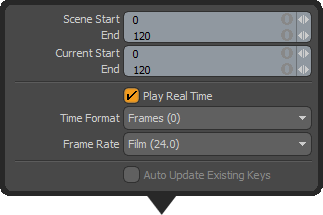
Scene Start/End: Sets the sequence length using the Start and End frame numbers.
Current Start/End: Sets the current length using the Start and End frame. When animating, users may wish to concentrate on a single area of a scene for fine tuning, the current range setting allows the users to essentially temporarily crop out the rest of the scene so they can concentrate on the one section. LMB+double click on the timeline to reset the 'Current' range to the 'Scene' range.
Play Real Time: When enabled the sequence will play back an OpenGL viewport using the 'Frame Rate' setting to the best of the host systems abilities, skipping frames if necessary. When disabled MODO will play every frame in the sequence at the fastest speed possible, which depending on scene complexity may be slower or faster than the specified frame rate.
Time Format: Allows the user to specify which standard is used when displaying individual frame numbers
Frames- Indicates frames as sequential numbers, using standard numbering format.
Seconds- Indicates frames as a passage of time, using the "0.0s" format.
SMPTE- SMPTE time code specifies frames utilizing a shorthand method "00:00:00:00"; representing hours:minutes:seconds:frames
Film Code- Specifies frames by the length of the film in feet (linear measurement) using "0.0 + 0" format.
Frame Rate: Users can specify a frame rate by standard definitions, such as Film (24 fps), PAL (25 FPS), and NTSC (29.97 fps). Frames Per Second, usually referred to as FPS, is the number of still images that playback in sequence in one second of time.
Auto Update Existing Keys: This option is only available when 'Auto Key' is 'Off'. Normally when Auto Key is off any edits that are made will be discarded when the current time is changed unless they have been manually keyed. This option allows existing keyframes to be updated automatically if their values are changed without requiring manual keying, un-keyed changes will still be discarded when the current time is changed.
Timeline Contextual Menu
When RMB+clicking on the timeline itself, a menu opens with a number of useful contextual options-
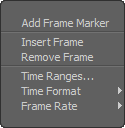 Add Frame Marker: This option adds a Frame Marker to the time marker lane above the timeline. Time Markers are documented in their own section.
Add Frame Marker: This option adds a Frame Marker to the time marker lane above the timeline. Time Markers are documented in their own section.
Insert Frame: This command inserts a single additional frame for all selected items, at the current time positions, pushing further keyframes out. Useful in adjusting keyframe positions for selected elements.
Remove Frame: This command removes a single frame for all selected items, at the current time positions, pulling further keyframes toward it (It does not delete keyframes). This is useful in adjusting keyframe positions for selected elements.
Time Ranges: This command opens a popup dialogue allowing users to numerically define either the 'Scene Range' or the 'Current Range'.
Time Format: Allows users a quick way to define the timeline display format (described below).
Frame Rate: Allows users a quick way to define the playback frame rate (described below).
Key Time
Key time is an indicator that represents the time at which keyframes will be created. It is also used by some commands that take a time input, for example the 'Insert Frame' and 'Remove Frame' commands. By default the 'Key' time is the same as the 'Current' time, when LMB+clicking or dragging in the Timeline, both the 'Current' and 'Key' times are set. MMB+clicking or dragging allows the 'Key' time to be set independently from the 'Current' time, this is indicated by a green marker in the Timeline. Pressing 'S' to keyframe selected channels will read values from the 'Current' time, but create keyframes at the 'Key' time, making it easy to copy item transform values from one point in time to another time in the scene, or when creating a looping animation, where the end frame needs to matches the first frame.
Using the 'Insert' and 'Remove' frame commands (comma and period shortcut keys) together with the 'Key' time is a powerful aid to adjusting the timing of animations. The Key time does not change when an animation is playing and can be set by MMB+clicking in the Timeline during playback. Positioning the Key time marker between keys allow the timing to be easily adjusted by using the Insert\Remove Frame shortcuts while viewing the results in the 3D viewport.
Keyframing Shortcuts
To aid users in setting keyframes while working with the time line in the Animation view, MODO provides a number of keyboard shortcuts, in addition to the interface buttons. This group allows you to quickly set keyframes on an entire item or specifically on the various transform elements or selected channels. When using the Key Selected Items command, keys will be created on any channels for that item that already contain at least one keyframe. Other channels for that item will not be keyed.
Shift-Y = Key transforms
Shift-E = Key Rotations
Shift-W = Key Positions
Shift-R = Key Scale
S = Key Selected Channels
Shift-S =Key Selected Items
These two commands quickly "slide" any keyframes forward or backwards that are after the current time. This is incredibly useful for quickly retiming portions of your animation.
, (comma)= Time Offset Forward
. (period)= Time Offset Backward
IMPORTANT: The Animation keyboard shortcuts listed on this page are part of the "Item mode" keymap. When MODO is in one of the component selection modes such as 'Vertices', 'Edges' or 'Polygons' many of these keys will perform important modeling tasks. This allows MODO to provide an efficient workflow for both processes.
Time Markers

Directly above the Timeline there is an additional lane where markers can be added to call out specific locations, or to highlight certain areas of a sequence. Users can also add tags to denote information or reminders about a sequence with special types of markers. By default the Time Marker lane is only visible in the Animation layout. In the other layouts with timelines it is hidden from view, maximizing the 3D viewport space above it. By LMB+clicking and dragging upward on the top of the Timeline frame the Time Marker lane can be revealed.
Adding Markers
Markers can be added anywhere along the timeline by MMB+clicking in the time marker lane, adding a new marker at the nearest whole frame location. A marker can also be added at the Current Time marker position by pressing 'm' on the keyboard (when the Timeline itself has input focus) or by RMB+clicking over the Timeline area and selecting the "Add Frame Marker" option from the contextual menu. Time Markers are are attached to Items in the scene depending on what is selected when the marker is added-
-
If there is a selected Locator type item, the marker is attached to it (this includes Mesh, Camera and Light items).
-
If there is an active 'Actor' and 'Action', but no selected Item the marker will be attached to the 'Action'.
-
If there is an active 'Actor' but no active 'Action' or selected Item the marker is attached to the 'Actor'.
-
If there is no active 'Actor' or 'Action' or a selected Item the marker is added to the scene.
When not a part of the scene, Markers will only appear when the associated elements are selected. 'Scene' markers will always appear, regardless of selection. The left hand margin area of the row provides feedback with a small icon of which type of item a new markers will be added to- a clapper board for 'Scene' markers, a cube for 'Locator' item markers, the standing actor in brackets for 'Actor' markers and the running actor for 'Action' markers.
![]()
Time markers can also be added to specific items by selecting the target markers and RMB+clicking in the marker lane on a blank area (not over a marker) and selecting the appropriate option from the contextual popup menu that opens-
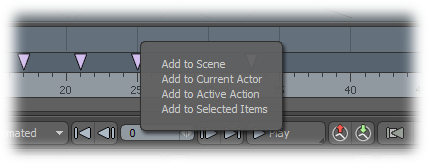
Selecting and Editing Markers
Time Markers can be moved along the lane after they are created by LMB+clicking directly on the marker and dragging to the new position. Multiple markers can be moved by Shift+LMB+click selecting additional markers and then dragging to the new location. LMB+clicking and dragging across multiple marker will selected the entire range, and simply LMB+clicking anywhere on the lane where there isn't a marker will clear the selection. RMB+clicking directly over a marker will open a contextual menu that allows users to control the markers position as well as customize the way the marker looks in the lane--
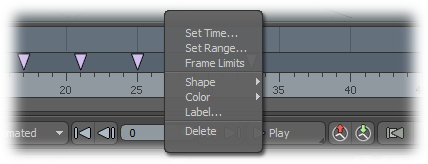
Set Time: This option opens a dialog allowing users to define a new time location for the target marker (if multiple markers are selected, then all will be moved to the specified 'Time' value).

Time: Defines the position on the timeline that the marker will be moved to, or defines a offset amount if the 'Relative' option is enabled.
Snap to Frames: All Frames markers, when moved, will be snapped to the nearest whole frame location.
Mode: These options control what effect the 'Time' control has-
Start Time- 'Time' value defines the marker location or the start position for a range marker
End Time- 'Time value defines the end position for a range marker
Shift- 'Time' value defines a frame offset amount from the markers current location (can be positive or negative)Relative: When the 'Relative' option is enabled, value will be shifted by the time value relative to their current position. When disabled, markers will be moved to the absolute time position along the timeline.
Set Range: This option opens the same 'Time Marker Time' dialog as the 'Set Time' option above, but the dialog defaults to the 'End Time' mode option with the 'Relative' control enabled.
Frame Limits: Range Markers can be defined as having limits which are supported by a number of commands in modo. This is set by choosing "Frame Limits" from the context menu. Range Markers with limits enabled are identified by the arrow graphic drawn in the center. If the marker has a label then it takes priority and the graphic is not drawn.
Frame Next/Previous- When stepping through frames the Range Marker will restrict the steps to the range of the marker, stepping will loop back to the start or end of the range depending on the direction. This is very useful for rolling poses, for example.
Animation Playback- Animation playback will look for Range Markers with limits and only play within the range of the marker. This only applies when the current time is within the range of the marker when playback is first started. Starting playback outside the range of the marker will play as normal.
GL Preview- Generating GL previews will use Range Markers with limits assigned if the current time is within the range of the marker when recording is started. If the current time is outside the marker range then the current scene range is used as normal.
Shape: This option provides several default shape types that users can assign to a given marker or selection of markers that include- 'Default' (downward triangle), 'Square', 'Diamond' and 'Bar'.
![]()
Color: This option provides users a means to color-code the marker (or Markers) from the list of standard available colors. Colors can also be applied to bar range markers.
Label: This control opens a dialog that allows users to assign a short text string to the marker. The test string will be visible as a 'tooltip' type popup when the users hovers the mouse pointer over the Marker, or when the 'Show Label' option is enabled, the test will appear above the marker itself.

Delete: Removed all selected markers from the timeline.
Range Markers
Range Markers are Time Markers that have a length of time associated with them. To create a Range Marker simply add a Time Marker and then click and drag on it with the right mouse button, the marker will change to a Range Marker and the length will be set interactively. The starting time of a Range Marker can be edited with the left mouse button and the end time with the right mouse button. When editing a single Range Marker the left mouse button can be used to change the start or end time by clicking and dragging near the start or end of the marker. Holding down the Shift key and dragging with the left mouse button will move the whole marker. If a Time Marker is moved into the range of a Range Marker, it will display on top of the Range Marker. The end time of a Range Marker can be edited numerically by choosing "Set Range..." from the contextual menu. The options are the same as for setting the Time Marker time described above apart from setting the "Mode" option to "End Time".
Special Markers
The 'Spacing Chart' tool assigns its own special types of Markers that are documented in the Spacing Chart tool page of the documentation.

Viewport Settings
In the Timeline Viewport Settings menu, users can toggle the display of different aspects of the timeline, customizing it to their particular needs. The menu can be opened with the Widget (the tiny triangular mark in the upper right corner of the timeline panel). LMB+clicking on the icon when highlighted opens a popup, where the following setting appear under the 'Viewport Settings' menu-
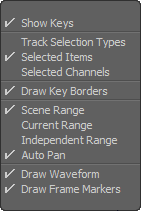 Show Keys: This option toggles the visibility of the keyframe markers in the timeline itself.
Show Keys: This option toggles the visibility of the keyframe markers in the timeline itself.
Track Selection Types: When this option is selected, MODO will track the selection type appropriately displaying the keyframes for either animated Items or animated Channels, depending on what is selected.
Selected Items: When this option is selected, timeline keyframes will only be visible when an Item that is animated is selected.
Selected Channels: When this option is selected, timeline keyframes will only be visible when a channel that is animated is selected.
Draw Key Borders: This option toggles the black outline visibility of the keyframe icons across the timeline.
The following settings pertain to the Track View when the timeline is extended upward to display additional keyframe handles for easily adjusting animation timing.
Scene Range: With this option enabled, the Track View will display the entire range of frames defined by the scene item.
Current Range: With this option enabled, the Track View will display only the current range as defined in the scene item.
Independent Range: With this option enabled, the Track View will have an additional control added to allow for an independent frame range form that of the timeline view itself.
Auto Pan: This option, when selected, will automatically pan the timeline so that the current time marker stays in the center of the timeline viewport, when working with a limited range view..
Draw Waveform: This option toggles the visibility of a waveform displayed in the background of the timeline viewport.
Draw Frame Markers: This option toggles the visibility of the Frame Markers lane above the Timeline.



